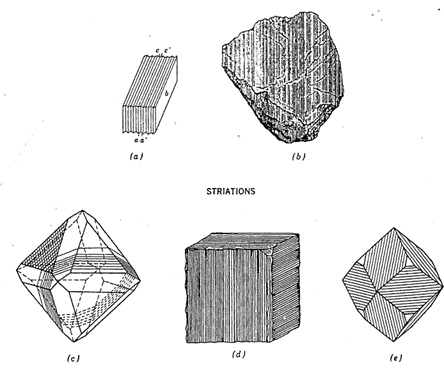Intergrowths, Twins, and Striations
Most minerals occur as random aggregates of grains in the rocks of the Earth. These grains are generally anhedral (lacking external faces), but, being crystalline, they possess an internal order evidenced by cleavage, optical properties, and X-ray diffraction.
There are, however, some relatively common intergrowth patterns of well-formed crystals (as well as anhedral grains) that are not random in nature. Such as parallel growths of the same crystalline substance, and crystallographically controlled (nonrandom) intergrowths of two or more crystals of the same substance that are related by a symmetry element (that is not normally present in either individual crystal). Such crystallographically controlled intergrowths are called twins or twinned crystals.
An aggregate of similar crystals with their crystallographic axes and faces parallel is called a parallel growth. Such aggregates, although they may at first appear to represent several crystals, are a single crystal because the internal (atomic) structure remains unchanged in orientation throughout the specimen. Figure 2.5 illustrates some types of parallel growth as found in quartz and barite.

FIG. 2.5. Examples of parallel growth, (a) Overgrowth of a larger crystal of quartz on a smaller one, forming the shape of a scepter. (b) The termination of a large quartz crystal in a collection of smaller crystals, all in parallel orientation. (c) Parallel intergrowth of barite crystals
A twin is a symmetrical intergrowth of two (or more) crystals of the same substance. Such crystallographic intergrowths are called twinned crystals. The two or more individuals of the twinned aggregate are related by a symmetry element that is absent in the original (untwinned) crystal (see pp. 208 to 213). Twinning is common in crystals, and the size of the twinned units can range from an almost atomic scale (with twin lamellae or twin domains on the order of tens to hundreds of angstroms in size) to such a large scale that the individuals are easily seen by the naked eye.
Generally the twins that are easiest to recognize in hand specimen are contact twins or penetration twins. Although the twinned relationship in such symmetric intergrowths is easily recognized, the twin law that underlies the twinned relationship may not be so obvious. Examples of some common contact and penetration twins are shown in Fig. 2.6.

FIG. 2.6. (a) Two quartz crystals twinned across a mirror plane. This is referred to as a contact twin because there is a definite surface separating the two individuals. (b) and (c) are examples of penetration twins in which the individuals are joined along an irregular surface and the twin axis is parallel to the vertical axis, (b) Pyrite crystals in which the two individuals are related by 90° rotation about the vertical axis, (c) Orthoclase crystals that are related by 180° rotation about the vertical axis
A twin relationship that is more subtle in its appearance is polysynthetic twinning. In a polysynthetic twin the successive composition planes of the twin are parallel to each other. When a large number of individuals in a polysynthetic twin are closely spaced, crystal faces or cleavage surfaces cutting across the composition planes show striations owing to the reversed positions of adjacent individuals. A highly diagnostic polysynthetic twin is albite twinning in the plagioclase feldspar series. The individual twin lamellae that can be seen by the naked eye are commonly quite thin, ranging from 0.1 to several millimeters in thickness. This twin is evidenced by parallel lines or striations seen on cleavage directions. The striations resulting from this polysynthetic twinning are shown in Figures 2.7 a and b. Polysynthetic twinning in a magnetite crystal is shown in Figure 2.7 c.

FIG. 2.7. Polysynthetic twinning and striations. (a) Albite polysynthetically twinned parallel to the vertical plane marked b; this plane is identified by the Miller index (010). (b) The appearance of albite twinning as striations or as parallel groovings across a cleavage surface or crystal face.
(c) Octahedral crystal of magnetite with twinning, lamellae appearing as striations on an octahedral face. (d) Striations on a cube of pyrite. (e) Striations on the faces of a dodecahedron of magnetite caused by the presence of octahedral faces (o) (From C. Klein, 1994, Minerals and Rocks: Exercises in Crystallography, Mineralogy and Hand Specimen Petrology, rev. ed. New York: Wiley, p. 308)
Striations, however, as seen on crystal faces, are by no means always the result of polysynthetic twinning. Figures 2.7 d and e show striations that result from the intergrowths of two forms. Pyrite cubes (Fig. 2.7 d) typically show striations that are the result of successive combinations of other faces or of another form (called a pyritohedron) in narrow lines with the cube. The magnetite crystal in Figure 2.7 e shows striations on the faces of a dodecahedron caused by the stepwise growth of octahedral faces (with triangular outline).
Date added: 2022-12-31; views: 701;
